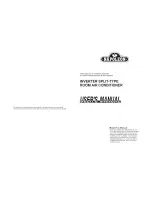
27
PB
OPERATION
Sequence Of Operations
Cooling Sequence:
The wall thermostat provides the temperature set point as well as the current dry bulb temperature and relative humidity. Upon a
call for cooling, the compressor modulates based on the difference between room temperature and set point. As cooling demand
decreases the compressor will modulate to a minimum speed. If the room temperature drops 2 °F below set point the compressor
will cycle off.
Heating Sequence:
The wall thermostat provides the temperature set point as well as the current dry bulb temperature and relative humidity. Upon a
call for heating, the compressor modulates based on the difference between room temperature and set point. As Heating demand
decreases the compressor will modulate to a minimum speed. If the room temperature raises 2 °F above set point the compressor
will cycle off.
Main Supply Fan Sequence:
Option 1:
(ON/Continuous) The Supply fan runs continuously
Option 2:
(Auto) The Supply fan cycles with the compressor.
Option 3:
(Smart Fan) The Supply fan cycles with the compressor. The fan will modulate based on the difference between
the space temperature and space set point.
IAQ Ventilation Fan Sequence:
Option 1:
(ON) The fan(s) runs at all times.
Option 2:
(OFF) The OSA fan(s) do not run.
Hot Gas Reheat Coil Sequence:
Once the sensible load of the space is satisfied, and if the relative humidity of the space is above 55%, the hot gas reheat coil will
be activated. The hot gas reheat coil will remain activated until the relative humidity drops below 50% or if the room temperature
creeps too far away from set point.
Auxiliary Electric Heat Sequence:
Auxiliary Heat is activated on a sliding scale based on outdoor ambient temperature and the difference between set point and room
temperature. During mild ambient conditions, the large difference between set point and actual room temperature is permitted. In
extreme low temperatures a smaller difference between the two are permitted energizing the auxiliary heat sooner.
Defrost:
The electric heat for the VRP is to be considered “back‐up” and not “supplemental”. At no point in time will the pump and electric
heat operate simultaneous. Normally, and in a vast majority of heating conditions, the heat pump will be the primary source of heat
(down to 0°F). Eventually, the outdoor coil may accumulate frost and the unit will require a defrost cycle. If the space is still 1
°
F
or more below set point, the VRP will stop heat pump operation and satisfy the space with electric heat. Once the room is satisfied
the VRP will operate the blower and condenser fans at their lowest speeds and run the compressor in the cooling cycle to defrost
the outdoor coil. The blower fan operates to help prevent the indoor coil from freezing during this process. Once the outdoor coil
rises above 46 degrees Farenheit, the defrost cycle will end and the unit will continue with normal operation based on the space
conditions and settings.
Summary of Contents for VRP12K
Page 46: ...46 OPERATION Component Identification Indoor Coil 36k ...
Page 48: ...48 OPERATION Component Identification Outdoor Coil Monitored by 1 thermistor ...
Page 49: ...49 OPERATION Component Identification Outdoor Fan BLDC Variable Speed 600 1000 RPM ...
Page 53: ...53 OPERATION Component Identification 4 Way Reversing Valve 208 230v Reversing valve assembly ...
Page 177: ...177 UPDATING VRP FIRMWARE Or ...
Page 184: ...184 UPDATING VRP FIRMWARE Open zip file Copy to SD Card Insert into SD Card Slot ...
Page 193: ...193 UPDATING VRP FIRMWARE Retrieving VRP Data Remove SD Card from FMC and Locate DF Folder ...
Page 196: ...196 WIRINGDIAGRAMS 12 24K BTU 208 230V 7 5 10 0 KW Figure 801 Wiring Diagram ...
Page 197: ...197 WIRING DIAGRAMS 12 24K BTU 208 230V 2 5 3 4 5 0 KW Figure 802 Wiring Diagram ...
Page 198: ...198 WIRING DIAGRAMS 12 24K BTU 265V 2 5 3 4 5 0 kW Figure 803 Wiring Diagram ...
Page 199: ...199 WIRING DIAGRAMS 12 24K BTU 265V 7 5 10 kW Figure 804 Wiring Diagram ...
Page 200: ...200 WIRING DIAGRAMS 36K BTU 208 230V Figure 805 Wiring Diagram ...
















































